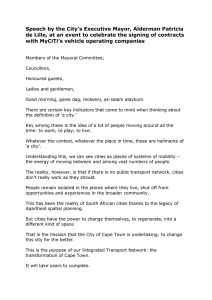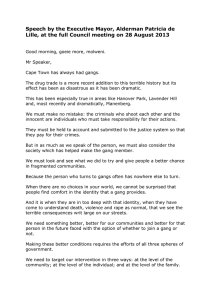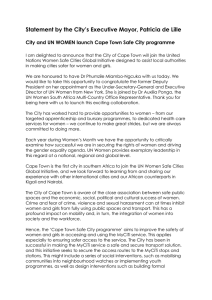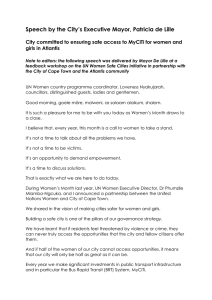Highlights – 2012 MyCiTi Business Plan
advertisement
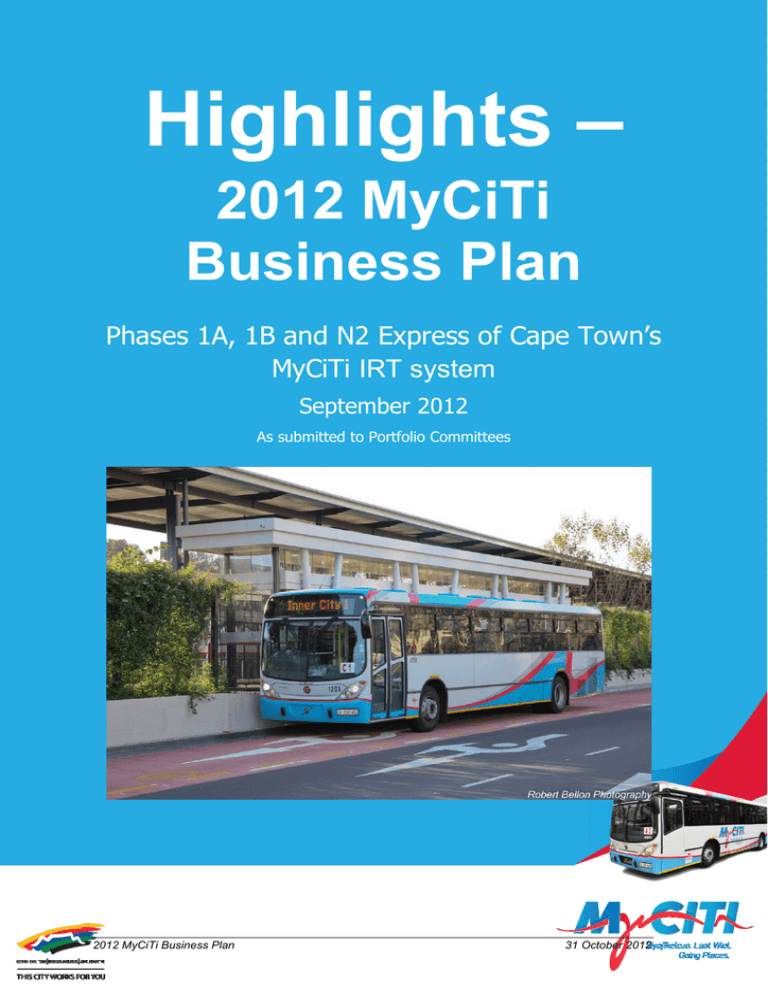
Highlights – 2012 MyCiTi Business Plan Phases 1A, 1B and N2 Express of Cape Town’s MyCiTi IRT system September 2012 As submitted to Portfolio Committees 2012 MyCiTi Business Plan 31 October 2012 i Highlights of the 2012 MyCiTi Business Plan The 2012 MyCiTi Business Plan provides for the extension of the MyCiTi system to Phase 1B and the N2 Express service, but it also incorporates and updates the content of the 2010 MyCiTi Business Plan, which addressed Phase 1A. Thus the 2012 MyCiTi Business Plan replaces previous business plan documents. In this regard, it is intended to inform and guide the City of Cape Town in the development, implementation and operation of the MyCiTi Integrated Rapid Transit system. This summary focuses on aspects that have been updated or changed in the new business plan. Background In October 2010, Council approved the 2010 MyCiTi Business Plan titled “Phase 1A of Cape Town’s MyCiTi Integrated Rapid Transit system”. Minor amendments to this plan were passed by Council in February and October 2011. There have been many developments since the approval of the 2010 business plan, including the start of trunk operations between the City Centre and Table View in May 2011, and the provision of a limited range of interim feeder services within the central area and around Table View. Tenders were awarded for the provision of an automated fare system and for the creation of a control centre to monitor and direct vehicles, and ensure they run to schedule. Both these systems are now largely implemented but not yet fully operational. Station services and related activities have been provided on an interim basis by two of the vehicle operating companies, and a tender for the provision of these services for a further six years is in the final stage of adjudication. The tender for further vehicles has been awarded, and includes the provision of nine-metre, low-floor vehicles. These are being assembled in Cape Town and the first of them will be brought into service later in 2012. More than 4.5 million passenger journeys have been provided since the start of the MyCiTi interim service. Vision for public transport The City’s vision for public transport is driven by the need to integrate various modes of public transport into a single effective and seamless service. This includes the establishment of a full public transport network, with high-quality rail and road services, that will place at least 75% of Cape Town’s population within 500 metres of the system. The Bus Rapid 2012 MyCiTi Business Plan 31 October 2012 ii Transit (BRT) network will link into the rail service, which will remain the backbone of public transport in Cape Town. The planning for this BRT service is guided by the principles of quality, equity, security, sustainability and integrity. This translates into design principles of universal access, passenger mobility, accessibility, modal integration, customer convenience, safety and security, sustainable transport, congestion management, the optimal use of scarce resources and transport that supports economic development. There is a clear linkage with the City’s Integrated Development Plan – which envisages a prosperous city that creates an enabling environment for shared economic growth and development, achieves effective and equitable service delivery, and serves the citizens of Cape Town with a well-governed and effectively run administration. Phased implementation The system will be rolled out in four phases, for completion in 15 to 20 years. Phase 1 focuses on the central city and the Blaauwberg corridor towards Table View and Dunoon, as far as Atlantis and Mamre. Phase 2 addresses the public transport needs of the metro southeast, including Khayelitsha and Mitchells Plain, linking these to the rest of the city. Phases 3 and 4 extend the system to the Durbanville, Delft and Helderberg areas. The N2 Express service is a short-term intervention to relieve pressure on existing services, such as rail, between the metro south-east and the central city. It will also allow certain innovations and lessons learned from Phase 1A to be tested in the south-east prior to their adoption as part of Phase 2. System plan The system plan, which forms part of the business plan, is informed by revealed travel data, lessons learnt from the operations of the system to date, and lessons from public transport systems in South Africa and abroad. The ability to accurately model travel behaviour is a challenge worldwide. The accuracy of the modelling results is enhanced through continuous improvement and refinement by calibrating the model with new transport data as it becomes available. Several years of planning and research have identified critical missing transport links in the public transport system. The Khayelitsha-to-CBD rail service, in particular, is running at over capacity, but this is driven to a large degree by a desire to access the Bellville and Wynberg/Claremont area from the metro south-east. The Chris Hani rail corridor has been identified for a significant upgrade and will be the backbone of the N2 corridor, which links the metro south-east to the Cape Town CBD. Meanwhile, the City has prioritised four further transport corridors for implementation, namely the West-Coast corridor, the East-West Lansdowne-Wetton corridor, the North-South Symphony Way corridor, and metro south-east to West Coast corridor. Given that it is not feasible at present to build rail lines along these routes, they will need to be served by bus rapid transit services. The N2 Express route network will consist of direct routes only, with existing services remaining to provide feeder services. This service will operate in both mixed traffic and the dedicated N2 BMT lane. There will be a few open stops with on-board fare collection and 2012 MyCiTi Business Plan 31 October 2012 iii verification, and enclosed terminal stations with off-board fare collection and verification. High-capacity vehicles with a high seating ratio are being investigated for use with universally accessible infrastructure. Low-floor and high-floor buses Level boarding (as is possible at MyCiTi stations, where the bus floor is level with the station floor) is an important component in providing a high-quality service which allows universal access and quick boarding and alighting, but requires station and bus stop platforms to be of the same height as the vehicle floor. The high-floor buses that were chosen for Phase 1A made more floor space available for passengers, cost less, weighed less and had less complex maintenance issues than low-floor buses, but required high station platforms. These buses offered both high-floor doors on the right side of the bus and a low-entry door with steps on the left hand side of the vehicle, enabling them to be used at feeder stops if necessary. However, the stepped entry on the left side into high-floor vehicles does not comply with required universal access standards, and results in buses having to dwell for longer periods at stops as passengers board through the single left-hand door, up the steps. The decision to implement a high-floor bus trunk system in combination with a low-entry feeder system also resulted in a number of infrastructure challenges in the implementation of Phase 1A, increasing the number of station platforms required, even where the demand is low. Using low-floor technology for trunk as well as feeder vehicles makes it easier to operate the same vehicle on both trunk and feeder routes, offering a more convenient, universally accessible service and greater flexibility in vehicle utilisation; however, such vehicles are more costly to purchase and maintain. The City thus intends introducing a low-floor trunk express bus service to Mitchells Plain and Khayelitsha as a test case for this new technology. Assuming the associated maintenance and cost challenges can be successfully addressed in future, the low-entry system will offer greater flexibility as the service extends into the highdensity areas of the metro south-east. The system will be fully accessible for passengers in wheelchairs and passengers with disabilities such as sight impairment. The network of dedicated bicycle and pedestrian pathways around the main bus trunk routes will also be a key feature. Because of their close integration, the system for Phase 1B must be the same as for Phase 1A, namely high-floor vehicles operating on the trunk routes and low-floor feeder vehicles on the feeder routes. Contactless card payment system The contactless card payment system remains part of the system’s development into future phases. The City’s contactless card, the myconnect card, is a core component, although any EMV compliant contactless cards can be used. Payment will take place at stations or on board the vehicles. Once fully implemented, the fare system will permit distance-based pricing capped at a defined maximum fare. Discounts will also be offered for frequent users. 2012 MyCiTi Business Plan 31 October 2012 iv Business structure In the initial phase, the central implementation, coordination and management of the system will take place through the MyCiTi Project Office within the City administration, reporting to the Executive Director: Transport, Roads and Stormwater, and consisting of two departments, namely the Department: IRT Implementation and the Department: IRT Operations. The City of Cape Town has overall responsibility for MyCiTi. The City determines where the system is to be rolled out, builds and maintains the infrastructure, and sets the terms under which the system operates. This includes the framework for establishing fare levels and, through negotiations with the MyCiTi Operations Management Unit, the level of additional finance to be contributed by the City to run the transport operations. Six main functions are envisaged regarding MyCiTi operations: • The MyCiTi Operations Management Unit, which is responsible for managing MyCiTi operations. This function presently falls within the City Department: IRT Operations. • Vehicle operations, provided by contracted vehicle operators, also referred to as vehicle operating companies (VOCs). • Automated fare collection (AFC). • Control centre (CC). • Station management (SM). • An advertising contractor, responsible for advertising on MyCiTi infrastructure and for maintenance of bus stops. At the heart of the MyCiTi system will be the VOCs, who are responsible for operating the vehicles necessary to provide the service. The City may sign contracts with three VOCs in Phase 1. However, if a reasonable agreement cannot be reached with any one or more of these companies, then contracts may be concluded with fewer companies. For phases 1A, 1B and the N2 Express, the City will purchase the initial fleet of vehicles with funds from the Public Transport Infrastructure and Systems Grant (PTISG). The vehicles will be held as City assets and made available to the VOCs at no cost, to be used and maintained by the VOCs for the length of the contract, during which time the vehicle supplier may be contracted to maintain the vehicles. After the initial 12-year period, the operators may be required to purchase their own vehicles. Vehicles purchased in addition to the initial fleet are expected to be purchased by the VOCs and paid for out of fare revenue. The City has identified the sale of advertising space on MyCiTi infrastructure as a source of income for the system. To help realise this revenue opportunity, the City has awarded the advertising contract to an outdoor media company to act as the City’s agent for marketing and managing advertising on IRT infrastructure. The advertising contractor is also responsible for the maintenance and cleaning of MyCiTi bus stops, funded from the sale of advertising. The City intends that retailers or others be awarded concessions to make use of retail infrastructure at MyCiTi stations, depots and staging areas. 2012 MyCiTi Business Plan 31 October 2012 v Transport Authority Further development of possible institutional arrangements for the management of MyCiTi will depend to some degree on the intended creation of the Transport Authority, and the form that this will take. The roles and responsibilities of the Transport Authority will include: • Planning • Contracting, in terms of which it would contract services such as MyCiTi operators and the current Golden Arrow Bus Services. • Municipal transport regulation, in terms of which it would issue operating licences and regulate the minibus-taxi and broader public transport industry. • Myconnect, the card-based fare system that will be rolled out across all public transport operators • Transport Management Centre and Transport Information Centre. • Setting of standards and monitoring and evaluation. • Rail management, in terms of which the City will exercise some level of control over the rail function in the City. This will impact on the institutional arrangements and staffing of MyCiTi in ways which will become clearer once the Transport Authority is formed. Authority for transport cannot be externalised from the City, hence the responsibility for key functions will remain with the City. However, the City will be using external mechanisms of various kinds to implement some of its responsibilities, and may create a municipal entity to perform some of the tasks. Costs and funding The costs of the MyCiTi service consist largely of the once-off capital expenses that are essential for initiating a quality service. These include road works, the construction of stations and stops, setting up the quality automated fare system, and the control system, which monitors safety and reliability. This includes ensuring that vehicles run to timetables and informing users about when buses will arrive. Costs also include the expenses of business and system design and planning, and the compensation of minibus-taxi operators who are giving up their rights to operate in the area. While infrastructure must be maintained, the substantial costs required for initial implementation will not need to be repeated. This and other capital expenditure is all funded by national government’s PTISG. Besides the once-off capital costs, there are ongoing recurrent costs incurred in running the system. Besides maintenance costs, these recurrent costs include the cost of contracts with service providers such as the vehicle operating companies, the fare collector, station management and the control centre. Fare revenue and advertising pays for a significant of these costs, with the remaining deficit currently shared between national government and the City. In Phase 1A, for the 2011/12 financial year, the City contributed R187 million from its property rates and other general revenue sources towards these recurrent costs. Both national government and the City are seeking funding and implementation approaches which, while ensuring high service standards, incentivise the containment of costs and 2012 MyCiTi Business Plan 31 October 2012 vi encourage prudent spending. By including the private sector and role-players from the industry, on a competitive basis where feasible, but retaining public control over the overall network, costs can be contained. The city’s urban form, with unusually low densities and long travel distances, together with peaked travel demand patterns and high income inequalities, makes the provision of quality public transport challenging and expensive. But a quality public transport system is essential to economic growth and ensuring that Cape Town achieves its full potential. In its request to the national government for funding MyCiTi for the Medium Term Expenditure Framework period, the City has proposed that national and City authorities share equally the burden of recurrent costs not covered by system revenues. This is in line with an earlier suggestion by National Treasury, and would incentivise containment of costs by the City while sharing the burden with national government. In the Council Resolution approving the 2012 MyCiTi Business Plan, Council approved that the City would contribute to payment of recurrent costs not covered by system revenues, but subject to a cap of four percent of the City’s rates income, a level slightly above 2011/12 spending levels. The City will engage with national government with the aim of reaching agreement in this regard. The City proposes that the City and national government would fund R128 million for the current financial year, increasing to R212 million for the 2015/16 financial year, for Phase 1A, Phase 1B and the N2 Express services combined. These amounts are all below the envisaged cap. The City is taking a conservative approach to cost and revenue modelling. Recent modelling suggests that fare revenue may well be as much as 25% higher than the figure assumed in the business plan, in which case the required contribution from Council’s own funding, as well as the national government subsidy, would be lower. Value Added Tax (VAT) contributes a substantial 14% to the costs. As a provider of public transport, MyCiTi has been classified as “VAT exempt”, which means that while VAT must be paid by contractors setting up and running the services, it cannot be recovered by the City from South African Revenue Services (SARS). National Treasury acknowledges the anomalies of this VAT approach (since the City can claim back VAT spent on other services, such as on the cost of building roads for use by private cars) and is investigating the matter. This anomaly is an example of a challenge being confronted by all cities in the implementation of this new system. The PTISG funding already received, and confirmed for the future, will cover the capital expenditure for Phase 1A, Phase 1B and the N2 Express, while co-funding recurrent costs. Up until end June 2012, the City had received R3.74 billion of the PTISG, and a further R3.94 billion has been committed until June 2015. National Treasury has provided a total of R7.7 billion to public transport in Cape Town between 2005 and 2014, largely dedicated to the MyCiTi system. Transition from existing to new vehicle operators Chapter 8 of the business plan describes the City’s approach to directly affected road-based public transport operators. A complex process is followed to determine the affected operator’s existing market share. The operator is then given an option to be paid out this share in order to exit the industry, or to be given the determined value as a percentage 2012 MyCiTi Business Plan 31 October 2012 vii share in the new vehicle operating company for the area in question. There are three possible rounds for payment of compensation, namely early exit compensation, early compensation and final stage compensation. Drivers and assistants who may lose their jobs when operators take up exit compensation will be given preference for training to qualify for new positions in the MyCiTi system. One of the main aims of MyCiTi is to improve the work environment for those currently employed in the minibus taxi industry. For the N2 Express service, it is proposed that two core VOCs be established through a negotiated process or a tender process. 2012 MyCiTi Business Plan 31 October 2012 2012 MyCiTi Business Plan 31 October 2012
